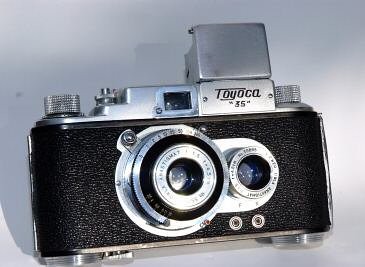Toyoca 35 (TLR)
The Toyoca 35[1] (トヨカ35) TLR, sometimes called "Toyocaflex 35" (トヨカフレックス35), is a Japanese 35mm TLR made by Tougodo from 1955 to 1957. The Haco 35 and Hulda 35 are name variants.
Contents
Description
The Toyoca 35 TLR is shaped as a conventional 35mm camera with a mirror box and viewing lens grafted on one side of the taking lens. There is an additional direct vision finder in the top housing, above the taking lens, essential to frame vertical pictures. The camera is considerably larger than contemporary viewfinder-only 35mm models, and is comparable in size to a large SLR of the 1970s. The main body was perhaps shared with the Owla Stereo, which has a similar shape and dimensions.[2]
The film runs horizontally and is advanced by a knob at the right end of the top plate, as seen by the photographer. The knob has an arrow indicating the turning direction, and its base is surrounded by an exposure counter; it is not coupled to the shutter, which must be cocked separately by hand. Next to the advance knob is the shutter release, surrounded by a removable milled cup which is sometimes missing on the examples found today; this release button is interlocked with the film advance for double exposure prevention. The accessory shoe is to the right of the direct vision finder. The viewing hood for the reflex finder is on the left, and contains a magnifying lens hinged at the front and erected by a small lever on the side. There is a condenser in the reflex finder, for brighter illumination of the corners, and the viewing screen has a cross and parallax indications on the left.[3] The rewind knob is at the left end of the top plate.
The camera name Toyoca 35, is engraved on a nameplate screwed above the viewing lens; variations in the engraving are known (see below), sometimes with quotes around "35". A lens-shaped logo, usually reading TOYOCA FLEX, is engraved above the direct vision finder, together with the number "35". The body serial number is inscribed in front of the accessory shoe.
  
|
 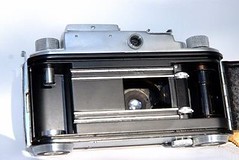 
|
| Toyoca 35 (TLR) no.56881, B, 1–300 speeds, silver lens rim. Pictures courtesy of Bernard Guéant. (Image rights) |
The back is hinged to the right; inside the camera the exposure chamber and pressure plate appear offset to the right because of the mirror box. There are knob-like flanges at both ends of the bottom plate. The one on the advance side contains a tripod thread, there is a smaller knob next to it, with A and R indications, to unlock the sprocket shaft for film rewind. The bottom plate also has the words MADE IN JAPAN engraved in small characters, at least on some examples.
  
|
| Direct release lever: early, intermediate and late. (Image rights) |
The two lenses and the shutter unit move together for focusing; the helix surrounding the taking lens is driven by a focusing tab. The shutter gives B, 1–200 or B, 1–300 speeds (see below) and has a self-timer. It has an additional release lever on the side, opposite the self-timer lever, used in case the user accidentally trips the main release without having cocked the shutter first: the lock for double exposure prevention then makes the main release inoperable and the loaded film frame would otherwise be lost.[4] There are two PC synch sockets buried in the main body under the viewing lens, with F and X indications corresponding to flash bulbs or electronic flash.
The taking lens is an Owla Anastigmat 4.5cm f/3.5 and the viewing lens is a Viewer Owla Anastigmat 4.5cm f/3.5; it is not known if their optical formula is the same.
Evolution
First version, NKS shutter
The camera was made in two main versions. The first version has an NKS shutter (B, 1–200), with either one of four different nameplates. The aperture scale is above the shutter casing and has the NKS logo. The black shutter plate sometimes has TOYOCA at the bottom, but this is not the sign of a shutter change.[5] The first version is also distinguished by the shape of the focusing tab, reproducing the shape of the fixed part of the focus mount. On the early examples, the infinity stop is hidden under the focusing tab and the minimum focusing distance is 2.5ft. On the late examples, an additional screw is added as an infinity stop and the minimum focusing distance is extended to 3ft.
  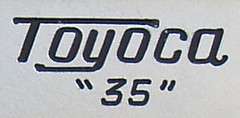
|
| Second, third and fourth nameplate variants (from left to right). (Image rights) |
At least four nameplate variants exist with the NKS shutter, presented in the presumed chronological order. The first nameplate has no underlining, a plain Toyoca with a squarish "y" letter and perhaps '35' in single quotes. It is only known from the April 1955 advertisement in Asahi Camera.[6] The pictured camera seems to have only a small button on the focus tab, instead of the larger cylindrical part found on most cameras.
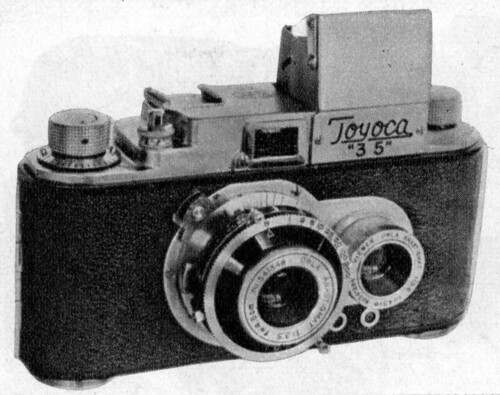
|
| Toyoca 35 (TLR), taking lens no.54134x, NKS shutter (B, 1–200), second nameplate variant. From the October 1955 special issue of Photo Art. (Image rights) |
The second nameplate has bars coming out of the letters "y" and "a", underlining the word Toyoca, and has "35" in double quotes. Pictures of a very early camera with this nameplate and the small button on the focus tab appear in various original documents.[7]
 
|
| Toyoca 35 (TLR) no.55059, taking lens no.541532, viewing lens no.541203, NKS shutter (B, 1–200), second nameplate variant. Pictures courtesy of Alexander Schulz. (Image rights) |

|
| Focusing mount of body no.55059. (Image rights) |
The camera pictured in this article, with body no.55059, is presumably very early — it is perhaps the 59th manufactured. It has the first type of focusing mount, with the infinity stop hidden underside the focusing tab. The depth-of-field indications are arranged in offset pairs. The distance scale only goes up to 25ft before reaching infinity, perhaps a very early feature. The cylindrical post on the focusing tab differs from that of regular production cameras. The camera has other early features, such as the accessory shoe retained by screws instead of rivets, and the angulous release lever on the side of the shutter casing.
Another early camera has been observed with the same release lever and a regular focusing tab.[8] It is known to have a smooth pressure plate and a single pair of guide rails — these features were modified at some point in the future. Slightly later cameras with the same nameplate, around body no.554xx, have the regular round release lever.[9]

|
| Toyoca 35 (TLR) no.55673, taking lens no.541121, viewing lens no.541446, NKS shutter (B, 1–200), third nameplate variant. Picture courtesy of Alexander Schulz. (Image rights) |
The third nameplate has the word Toyoca underlined from the bottom of the "T" to the end of the "a", with a round "y" letter and no quotes around 35. Body numbers are known in the 556xx to 558xx range.[10] It seems that the distance and scale was slightly altered around that time, with an engraving for 35ft instead of 25ft, and differently positioned depth-of-field indications.
The fourth nameplate has long bars coming out of the "T" and "y" letters and double quotes.[11] It is the same as later fitted on the cameras of the second version, with 1/300 top speed. It sometimes appears on quite early cameras, including one pictured in Sugiyama with the older angulous direct release lever.[12]
 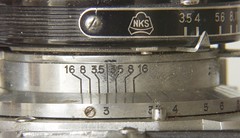
|
| Focusing mount and distance scale: first and second type. (Image rights) |
Later cameras with the same nameplate adopted the second type of focusing mount.[13] The infinity stop hidden under the focusing tab was replaced by an additional screw to the side. The minimum distance was certainly set to 3ft at the same time, displacing the stop-screw on the other end of the focusing mount, and the depth-of-field numbers were arranged in a single line instead of the previous offset configuration.
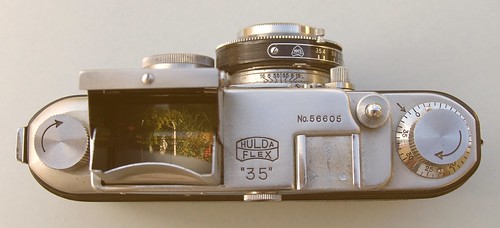
|
| Hulda 35 no.56605, NKS shutter, HULDA FLEX logo. Picture courtesy of Alexander Schulz. (Image rights) |
The Hulda 35 name variant was made at that period. It normally has a HULDA "35" nameplate and a HULDA FLEX logo at the top, and shows no other difference.[14] Some examples have mismatched markings, with the Hulda logo and Toyoca nameplate, or the reverse.[15] Body numbers are known in the 564xx to 566xx range.
Second version, 1/300 top speed
|
|
On the second version, the NKS shutter was replaced by a different no-name shutter (B, 1–300), perhaps made by Tougodo itself. The new shutter is distinguished by a different position and shape of the shutter cocking lever, and by the aperture scale moved to the bottom of the shutter plate. The focusing mount was modified again at the same time: the third type of focusing mount has a new tab, an infinity stop integrated in the base of the mount, and a close focusing distance of 3.5ft.
Compared with the very early cameras, those of the second version have a slightly larger pressure plate, with a pattern certainly providing some suction effect on the film surface, and have a dual pair of guide rails in the exposure chamber — these features were perhaps introduced at some point during the production of the first version.
 
|

|

| |
| Toyoca 35 (TLR) no.56881, B, 1–300 speeds, silver lens rim. Pictures courtesy of Bernard Guéant. (Image rights) | |
All the cameras of the second version have the fourth nameplate type. The early examples retain the silver taking lens rim of the previous version.[16] Body numbers are known in the 567xx to 571xx range.
The Haco 35 name variant was made at the same period. It was probably intended for export by the same distributor as the Haco-44 TLR.[17] The only example known so far is pictured in Sugiyama.[18] The nameplate reads HACO "35", and it is unclear if the top housing has TOYOCA or HACO.
 
|
| Toyoca 35 (TLR) no.57205, taking lens no.56818, viewing lens no.541247, B, 1–300 speeds, black lens rim. Pictures courtesy of Alexander Schulz. (Image rights) |
The last examples have a black instead of silver taking lens bezel.[19] Body numbers are known in the 571xx to 575xx range.
Commercial life

|
| Column on the Toyoca 35 (TLR) in the October 1955 special issue of Photo Art. (Image rights) |

|
| Toyoca 35 (TLR) in Shashin Kōgyō Summer 1957. (Image rights) |
The Toyoca 35 TLR was featured in Japanese magazines dated February 1955, and was first advertised on the same month.[20] Advertisements dated April, June and November 1955 give the price of ¥11,000 (case included).[21] In all these, the shutter is mentioned as an NKS (B, 1–200), and the pictured camera corresponds to the first version. As said above, the example pictured in the April advertisement is presumably a prototype, with the first nameplate variant. That pictured in June and November is certainly a later prototype, with the second nameplate variant. The same picture also appears in October 1955 special issue of Photo Art.[22]
The November 1956 advertisement in Asahi Camera gives the price of ¥1956, with ¥1,000 extra for the case.[23] The shutter name is not mentioned. In the picture, the aperture scale is at the bottom, indicating that the camera is of the second version, and the taking lens has a silver rim.
The last reported advertisement is dated January 1957.[24] The camera is listed again in the Summer 1957 special issue of Shashin Kōgyō on Japanese cameras, at an unchanged price (¥11,000).[25] The document shows an outdated picture of a camera with NKS shutter. This is the last known mention of the Toyoca 35 TLR.
Total production
The observed or reported body numbers of the Toyoca 35, Haco 35 and Hulda 35 have five digits in the 55xxx, 56xxx and 57xxx range; the first two digits might indicate the year of production but this is yet unclear.[26] The known taking and viewing lens numbers usually have either six digits in the 541xxx range or five digits in the 55xxx range; a few taking lenses have a five-digit number in the 56xxx or 580xx range, and viewing lenses might exist in the 56xxx range.[27] The spanned range tends to indicate that the viewing and taking lenses were numbered in separate sequences; the lens number prefix might indicate the year of production too. The total production can be estimated at about 2,500 units.
Notes
- ↑ "Toyoca" is certainly the contraction of Toyohashi — Tougodo's hometown — and Camera.
- ↑ This is convincingly suggested in Schulz, pp.68–9 of Photographica Cabinett no.44.
- ↑ Details of the reflex finder: Awano, p.155 of Kurashikku Kamera Senka no.35.
- ↑ Release lever described in Awano, p.155 of Kurashikku Kamera Senka no.35. It is visible on the cameras with 1/200 and 1/300 top speed.
- ↑ Compare the cameras pictured in Sugiyama, items 3822 and 3823: the shutter controls are identical and the only difference is the TOYOCA marking (and the nameplate variant).
- ↑ Advertisement reproduced in Kokusan kamera no rekishi, p.152.
- ↑ Advertisements in Sankei Camera June 1955 and in Asahi Camera November 1955 reproduced in Kokusan kamera no rekishi, p.152, and column in the October 1955 special issue of Photo Art, p.73.
- ↑ Example observed in an online auction.
- ↑ Example (taking lens no.541367) pictured in Sugiyama, item 3823, and example (no.55444) pictured in Awano, p.155 of Kurashikku Kamera Senka no.35, in Watakushi no ni-gan-refu kamera-ten, p.31, and in Kamera no ayumi, p.228.
- ↑ Examples pictured in this article (no.55673), in a page formerly displayed at the Kamera Tenjiba website, in this page at Nekosan (archived), and observed in online auctions.
- ↑ The fourth and fifth nameplates mentioned in Schulz, p.20 of Photographica Cabinett no.43, are actually identical, and correspond to this fourth nameplate.
- ↑ Examples pictured in Sugiyama, item 3822, and sold as lot no.226 of Christies sale no.8852 (August 24, 2000).
- ↑ Examples pictured in this page at Historic Camera, and one sold as lot no.403 of Westlicht Photographica auction no.1 (November 15, 2002); see links below.
- ↑ With HULDA "35" nameplate and HULDA FLEX logo: examples pictured in this article (no.56605) and in Kuno, p.130 of Kurashikku Kamera Senka no.10, and one sold as lot no.770 of Westlicht Photographica auction no.14 (November 30, 2008); see links below.
- ↑ With HULDA "35" nameplate and TOYOCA FLEX logo: example pictured in the 18 December 1996 Christies auction catalogue, lot no.187. With Toyoca "35" nameplate and HULDA FLEX logo: example sold as lot no.403 of Westlicht Photographica auction no.1 (November 15, 2002); see links below.
- ↑ Examples pictured in this article (no.56881), in McKeown, p.932 (where the shutter is wrongly described as an "NSK"), in Kuno, pp.129–30 of Kurashikku Kamera Senka no.10, and sold as lot no.161 of Christies sale no.9193 (September 18, 2001).
- ↑ Sugiyama, item 3271, says that it was an export version.
- ↑ Sugiyama, item 3271.
- ↑ Examples pictured in this article (no.57205), sold as lot no.224 and lot no.225 of Christies sale no.8852 (August 24, 2000), and observed in an online auction.
- ↑ Kokusan kamera no rekishi, p.356.
- ↑ Advertisements published in Asahi Camera or Sankei Camera, reproduced in Kokusan kamera no rekishi, p.152.
- ↑ October 1955 special issue of Photo Art, p.73.
- ↑ Advertisement reproduced in Kokusan kamera no rekishi, p.152.
- ↑ Kokusan kamera no rekishi, p.356.
- ↑ Column in Shashin Kōgyō no.63, p.111, reproduced in this page. It is not listed in Kokusan kamera no rekishi, p.356.
- ↑ Known body numbers: from 55059 to 55831, from 56470 to 56881, and from 57008 to 57509.
- ↑ Known taking lens numbers: from 541024 to 541918, from 55109 to 55911, 56287, 56340, 56818, 58026 and 58070 (the latter three have black bezels). Known viewing lens numbers: from 541154 to 541930, and from 55115 to 55855, and perhaps 56035 or 56935.
Bibliography
- Asahi Camera (アサヒカメラ) editorial staff. Shōwa 10–40nen kōkoku ni miru kokusan kamera no rekishi (昭和10–40年広告にみる国産カメラの歴史, Japanese camera history as seen in advertisements, 1935–1965). Tokyo: Asahi Shinbunsha, 1994. ISBN 4-02-330312-7. Item 629. (See also the advertisements for items 628 and 630.)
- Awano Mikio (粟野幹男). "Aishō 'yoko-nigan' no 35mm-ki: Toyokafurekkusu 35 [Toyoka 35]" (愛称'横二眼'の35mm機・トヨカフレックス35[トヨカ35], The Toyocaflex 35 [Toyoca 35], a so-called 'horizontal TLR' 35mm camera.) Kamera Rebyū: Kurashikku Kamera Senka (カメラレビュー クラシックカメラ専科) / Camera Review: All about Historical Cameras no.35, November 1995. Nihon no kamera 50nen (日本のカメラ50年, special issue on 50 years of Japanese cameras). P.155.
- Christies auction catalogue: "Rare 35mm and Other Cameras" (18 December 1996), lot no.187 (Hulda 35).
- Kamera no ayumi. Zen nihon shashin renmei sōritsu 50-shūnen kinen (カメラのあゆみ・全日本写真連盟創立五〇周年記念, History of cameras, commemorating the 50th anniversary of the All Japan Association of Photographic Societies). Tokyo: Asahi Shinbunsha, 1976. No ISBN number. P.228.
- Kuno Mikio (久野幹雄). "35mm-han nigan-refu no sekai" (35mm判二眼レフの世界, The world of 35mm TLRs.) Kamera Rebyū: Kurashikku Kamera Senka (カメラレビュー クラシックカメラ専科) / Camera Review: All about Historical Cameras no.10, September 1987. No ISBN number. Konishiroku kamera no rekishi (小西六カメラの歴史, special issue on Konishiroku). Pp.128–30.
- McKeown, James M. and Joan C. McKeown's Price Guide to Antique and Classic Cameras, 12th Edition, 2005-2006. USA, Centennial Photo Service, 2004. ISBN 0-931838-40-1 (hardcover). ISBN 0-931838-41-X (softcover). P.932.
- Photo Art rinji zōkan: Kamera no chishiki (フォトアート臨時増刊・カメラの知識, Photo Art special issue: Knowledge of cameras). October 1955, no.87 of the magazine. "Kokusan kamera no hatten 1: 35-miri kamera" (国産カメラの祭典1・35ミリカメラ), article on 35mm cameras, pp.71–82.
- Schulz, Alexander. "Kameras aus dem Hause Tougo Teil 2" (Cameras of the Tougo firm, part 2). In Photographica Cabinett no.43 (April 2008). Pp.16–20.
- Schulz, Alexander. "Die Owla Stereokamera" (The Owla stereo camera). In Photographica Cabinett no.44 (September 2008). Pp.64–70. (Compares the body of the Toyoca 35 with that of the Owla Stereo.)
- Shashin Kōgyō no.63 (Summer 1957). "Nihon no kamera zenbō: 35-miri kamera renzu shatā tsuki" (日本のカメラ全貌・35ミリカメラ・レンズシャター付, Compendium of Japanese cameras: 35mm cameras with lens shutter.) P.111.
- Sugiyama, Kōichi (杉山浩一); Naoi, Hiroaki (直井浩明); Bullock, John R. The Collector's Guide to Japanese Cameras. 国産カメラ図鑑 (Kokusan kamera zukan). Tokyo: Asahi Sonorama, 1985. ISBN 4-257-03187-5. Items 3271 and 3822–3.
- Watakushi no ni-gan-refu kamera-ten (私の二眼レフカメラ展, Exhibition of twin lens reflex cameras). Tokyo: JCII Camera Museum, 1992. (Exhibition catalogue, no ISBN number.) P.31.
Links
In English:
- Marriage, John. History of the 35mm Twin Lens Reflex (archived at Internet Archive in 2021)
- 35mm TLR at Massimo Bertacchi's Innovative cameras, also reproduced here at Fotografia e Reflex (archived) (these pages are based on the above article by John Marriage)
- Past auctions by Westlicht Photographica Auction (now Leitz Photographica Auction):
- Toyoca 35 (with Hulda Flex logo); lot no.403 of the first auction (November 15, 2002)
- Toyoca 35 (second nameplate version; no name on the shutter); lot 549 of the 26th Auction (March 2014).
- Toyoca 35 (fourth nameplate type); lot 456 of the 20th auction (November 12, 2011)
- Hulda 35; lot no.770 of the fourteenth auction (November 30, 2008)
- Past auctions by Christie's:
- Toyoca 35, lot no.224, lot no.225 and lot no.226 of sale no.8852 (August 24, 2000)
- Toyoca 35, lot no.161 of sale no.9193 (September 18, 2001)
- Toyoca 35 among Tougodo cameras at Nekosan's website (archived)
